值得一看的英语主谓宾句型
- 格式:doc
- 大小:26.50 KB
- 文档页数:6
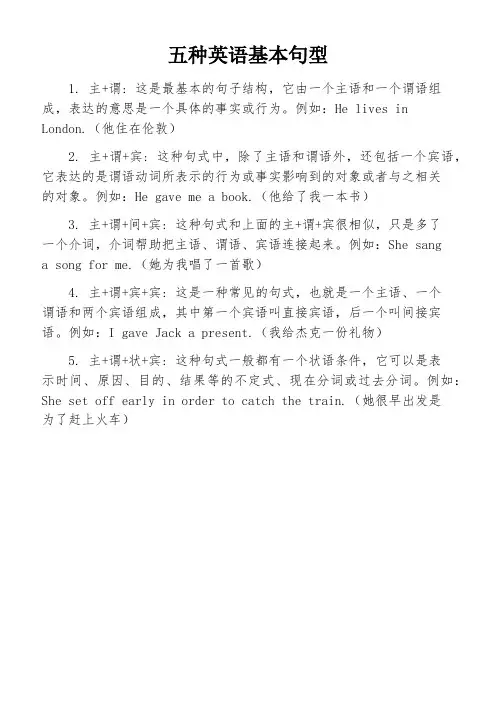
五种英语基本句型
1. 主+谓: 这是最基本的句子结构,它由一个主语和一个谓语组成,表达的意思是一个具体的事实或行为。
例如:He lives in London.(他住在伦敦)
2. 主+谓+宾: 这种句式中,除了主语和谓语外,还包括一个宾语,它表达的是谓语动词所表示的行为或事实影响到的对象或者与之相关
的对象。
例如:He gave me a book.(他给了我一本书)
3. 主+谓+间+宾: 这种句式和上面的主+谓+宾很相似,只是多了
一个介词,介词帮助把主语、谓语、宾语连接起来。
例如:She sang
a song for me.(她为我唱了一首歌)
4. 主+谓+宾+宾: 这是一种常见的句式,也就是一个主语、一个
谓语和两个宾语组成,其中第一个宾语叫直接宾语,后一个叫间接宾语。
例如:I gave Jack a present.(我给杰克一份礼物)
5. 主+谓+状+宾: 这种句式一般都有一个状语条件,它可以是表
示时间、原因、目的、结果等的不定式、现在分词或过去分词。
例如:She set off early in order to catch the train.(她很早出发是
为了赶上火车)。
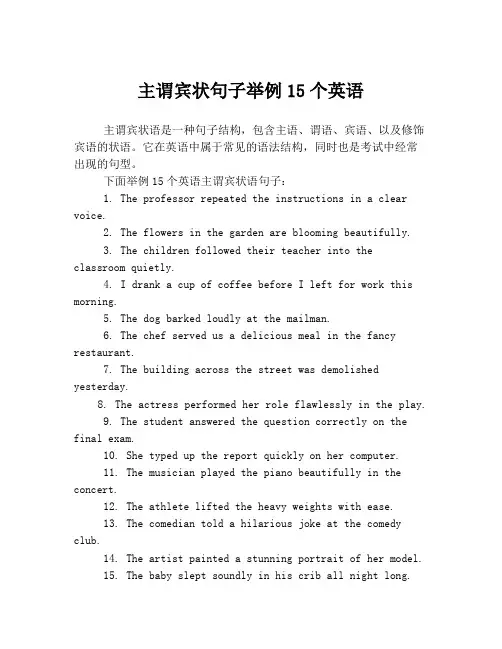
主谓宾状句子举例15个英语主谓宾状语是一种句子结构,包含主语、谓语、宾语、以及修饰宾语的状语。
它在英语中属于常见的语法结构,同时也是考试中经常出现的句型。
下面举例15个英语主谓宾状语句子:1. The professor repeated the instructions in a clear voice.2. The flowers in the garden are blooming beautifully.3. The children followed their teacher into the classroom quietly.4. I drank a cup of coffee before I left for work this morning.5. The dog barked loudly at the mailman.6. The chef served us a delicious meal in the fancy restaurant.7. The building across the street was demolished yesterday.8. The actress performed her role flawlessly in the play.9. The student answered the question correctly on the final exam.10. She typed up the report quickly on her computer.11. The musician played the piano beautifully in the concert.12. The athlete lifted the heavy weights with ease.13. The comedian told a hilarious joke at the comedy club.14. The artist painted a stunning portrait of her model.15. The baby slept soundly in his crib all night long.以上15个例子呈现了主谓宾状语在英语中的常见用法,可见在表达语句时,需要掌握好主谓宾状语的结构特点,从而正确地构建句子。
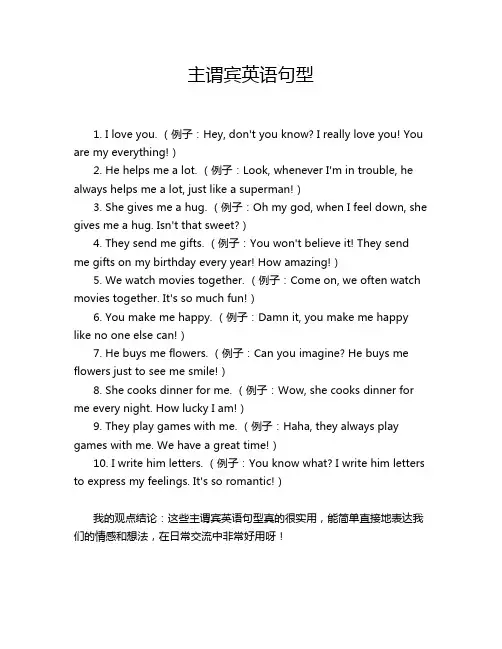
主谓宾英语句型1. I love you. (例子:Hey, don't you know? I really love you! You are my everything!)2. He helps me a lot. (例子:Look, whenever I'm in trouble, he always helps me a lot, just like a superman!)3. She gives me a hug. (例子:Oh my god, when I feel down, she gives me a hug. Isn't that sweet?)4. They send me gifts. (例子:You won't believe it! They send me gifts on my birthday every year! How amazing!)5. We watch movies together. (例子:Come on, we often watch movies together. It's so much fun!)6. You make me happy. (例子:Damn it, you make me happy like no one else can!)7. He buys me flowers. (例子:Can you imagine? He buys me flowers just to see me smile!)8. She cooks dinner for me. (例子:Wow, she cooks dinner for me every night. How lucky I am!)9. They play games with me. (例子:Haha, they always play games with me. We have a great time!)10. I write him letters. (例子:You know what? I write him letters to express my feelings. It's so romantic!)我的观点结论:这些主谓宾英语句型真的很实用,能简单直接地表达我们的情感和想法,在日常交流中非常好用呀!。
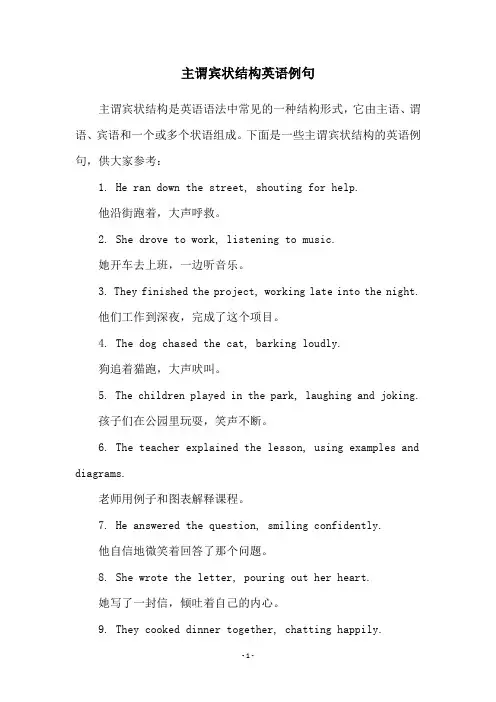
主谓宾状结构英语例句主谓宾状结构是英语语法中常见的一种结构形式,它由主语、谓语、宾语和一个或多个状语组成。
下面是一些主谓宾状结构的英语例句,供大家参考:1. He ran down the street, shouting for help.他沿街跑着,大声呼救。
2. She drove to work, listening to music.她开车去上班,一边听音乐。
3. They finished the project, working late into the night.他们工作到深夜,完成了这个项目。
4. The dog chased the cat, barking loudly.狗追着猫跑,大声吠叫。
5. The children played in the park, laughing and joking.孩子们在公园里玩耍,笑声不断。
6. The teacher explained the lesson, using examples and diagrams.老师用例子和图表解释课程。
7. He answered the question, smiling confidently.他自信地微笑着回答了那个问题。
8. She wrote the letter, pouring out her heart.她写了一封信,倾吐着自己的内心。
9. They cooked dinner together, chatting happily.他们一起做晚饭,愉快地聊天。
10. The birds flew over the trees, singing sweetly.鸟儿飞过树林,甜美地歌唱着。
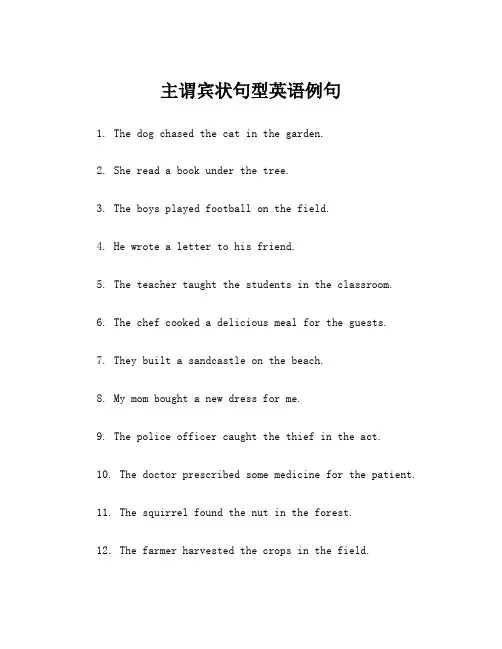
主谓宾状句型英语例句1. The dog chased the cat in the garden.2. She read a book under the tree.3. The boys played football on the field.4. He wrote a letter to his friend.5. The teacher taught the students in the classroom.6. The chef cooked a delicious meal for the guests.7. They built a sandcastle on the beach.8. My mom bought a new dress for me.9. The police officer caught the thief in the act.10. The doctor prescribed some medicine for the patient.11. The squirrel found the nut in the forest.12. The farmer harvested the crops in the field.13. The artist painted a beautiful landscape on the canvas.14. My grandmother knitted a sweater for me.15. The mechanic fixed the car in the garage.16. The secretary typed a report for the boss.17. The carpenter built a table for the family.18. The astronaut explored the moon in the spaceship.19. The tailor sewed a new dress for the customer.20. The musician composed a song for the band.21. The gardener planted flowers in the garden.22. The architect designed a new building for the city.23. The engineer constructed a bridge over the river.24. The scientist discovered a new species in the jungle.25. The pharmacist filled the prescription for the customer.26. The bartender mixed a cocktail for the customer.27. The lifeguard rescued a swimmer from drowning.28. The journalist interviewed a celebrity for the magazine.29. The librarian catalogued the new books in the library.30. The referee officiated the soccer match on the field.31. The firefighter extinguished the fire in the building.32. The waiter served the food to the customers.33. The pilot flew the plane to the new destination.34. The lawyer defended the client in the courtroom.35. The actress performed a monologue on the stage.36. The receptionist welcomed the guests to the hotel.37. The student recited a poem in front of the class.38. The salesperson sold a product to the customer.39. The painter created a masterpiece on the canvas.40. The dancer choreographed a routine for the competition.41. The cleaner mopped the floor in the office.42. The builder constructed a new house for the family.43. The programmer developed a new software for the company.44. The barber cut the man's hair at the salon.45. The singer performed a concert for the audience.46. The producer produced a new film for the studio.47. The translator translated the document into Spanish.48. The baker baked a cake for the birthday party.49. The jeweler crafted a beautiful necklace for the customer.50. The referee blew the whistle to start the game.。
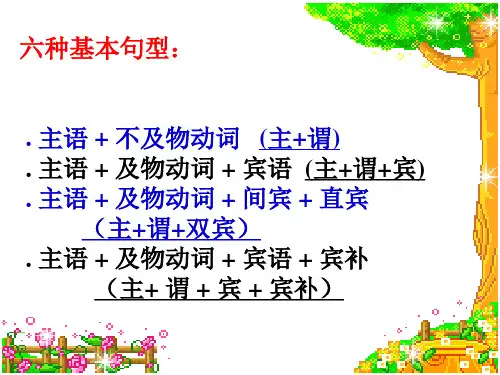

英语主谓宾结构句子
英语中的主谓宾结构句子是一种基本的语法结构,由主语、动词和宾语组成。
以下是一些例子:
1. I eat an apple.(我吃一个苹果。
)
2. She reads a book.(她读一本书。
)
3. They watch a movie.(他们看一部电影。
)
4. He loves his dog.(他爱他的狗。
)
5. We drink coffee.(我们喝咖啡。
)
6. The cat caught a mouse.(那只猫抓到了一只老鼠。
)
7. He bought a new car.(他买了一辆新车。
)
8. She opened the window.(她打开了窗户。
)
9. They visited their grandparents.(他们拜访了他们的祖父母。
)
10. We booked a hotel room.(我们预订了一个酒店房间。
以上句子中,主语为第一人称和第三人称代词或名词,动词为动作动词或连系动词,宾语为名词或代词。
这些句子都满足主谓宾结构的基本要求。
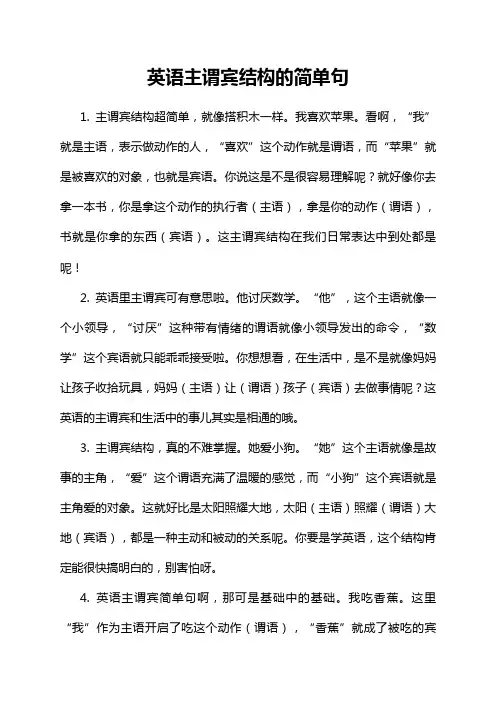
英语主谓宾结构的简单句1. 主谓宾结构超简单,就像搭积木一样。
我喜欢苹果。
看啊,“我”就是主语,表示做动作的人,“喜欢”这个动作就是谓语,而“苹果”就是被喜欢的对象,也就是宾语。
你说这是不是很容易理解呢?就好像你去拿一本书,你是拿这个动作的执行者(主语),拿是你的动作(谓语),书就是你拿的东西(宾语)。
这主谓宾结构在我们日常表达中到处都是呢!2. 英语里主谓宾可有意思啦。
他讨厌数学。
“他”,这个主语就像一个小领导,“讨厌”这种带有情绪的谓语就像小领导发出的命令,“数学”这个宾语就只能乖乖接受啦。
你想想看,在生活中,是不是就像妈妈让孩子收拾玩具,妈妈(主语)让(谓语)孩子(宾语)去做事情呢?这英语的主谓宾和生活中的事儿其实是相通的哦。
3. 主谓宾结构,真的不难掌握。
她爱小狗。
“她”这个主语就像是故事的主角,“爱”这个谓语充满了温暖的感觉,而“小狗”这个宾语就是主角爱的对象。
这就好比是太阳照耀大地,太阳(主语)照耀(谓语)大地(宾语),都是一种主动和被动的关系呢。
你要是学英语,这个结构肯定能很快搞明白的,别害怕呀。
4. 英语主谓宾简单句啊,那可是基础中的基础。
我吃香蕉。
这里“我”作为主语开启了吃这个动作(谓语),“香蕉”就成了被吃的宾语。
你可以把主语想象成厨师,谓语就是厨师做菜的动作,宾语就是那道菜。
你要是想学好英语,这个结构就像开门的钥匙,可重要啦。
5. 瞧,主谓宾多直白。
他们踢足球。
“他们”是主语,一群人呢,“踢”这个谓语多有活力,“足球”就被踢来踢去成了宾语。
这就好像一群小伙伴抢宝藏,小伙伴们(主语)抢(谓语)宝藏(宾语)。
这英语里的主谓宾是不是像个有趣的游戏?6. 哇哦,主谓宾结构可好玩啦。
你看,我写作业。
“我”是主语,是做这件事的人,“写”这个谓语是具体的行为,“作业”就是写的对象,是宾语。
这就跟你在花园里种花一样,你(主语)种(谓语)花(宾语),是不是很形象呢?学会了这个结构,英语就像开了一扇小窗,能看到更多风景啦。
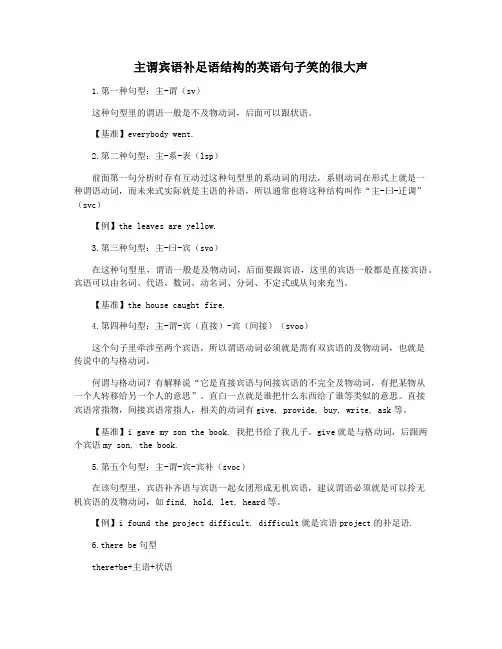
主谓宾语补足语结构的英语句子笑的很大声1.第一种句型:主-谓(sv)这种句型里的谓语一般是不及物动词,后面可以跟状语。
【基准】everybody went.2.第二种句型:主-系-表(lsp)前面第一句分析时存有互动过这种句型里的系动词的用法,系则动词在形式上就是一种谓语动词,而未来式实际就是主语的补语,所以通常也将这种结构叫作“主-曰-迁调”(svc)【例】the leaves are yellow.3.第三种句型:主-曰-宾(svo)在这种句型里,谓语一般是及物动词,后面要跟宾语,这里的宾语一般都是直接宾语。
宾语可以由名词、代语、数词、动名词、分词、不定式或从句来充当。
【基准】the house caught fire.4.第四种句型:主-谓-宾(直接)-宾(间接)(svoo)这个句子里牵涉至两个宾语,所以谓语动词必须就是需有双宾语的及物动词,也就是传说中的与格动词。
何谓与格动词?有解释说“它是直接宾语与间接宾语的不完全及物动词,有把某物从一个人转移给另一个人的意思”。
直白一点就是谁把什么东西给了谁等类似的意思。
直接宾语常指物,间接宾语常指人,相关的动词有give, provide, buy, write, ask等。
【基准】i gave my son the book. 我把书给了我儿子。
give就是与格动词,后跟两个宾语my son, the book.5.第五个句型:主-谓-宾-宾补(svoc)在该句型里,宾语补齐语与宾语一起女团形成无机宾语,建议谓语必须就是可以拎无机宾语的及物动词,如find, hold, let, heard等。
【例】i found the project difficult. difficult就是宾语project的补足语.6.there be句型there+be+主语+状语这个句型其实属消音的一种,主语后置,there做为鼓励词,并无实际意义。
例如:there are many children in the park.7.主语+谓语+状语这个句型是在主谓结构后通过状语对语义进行修饰补充,充当状语的一般是副词、介词短语等。
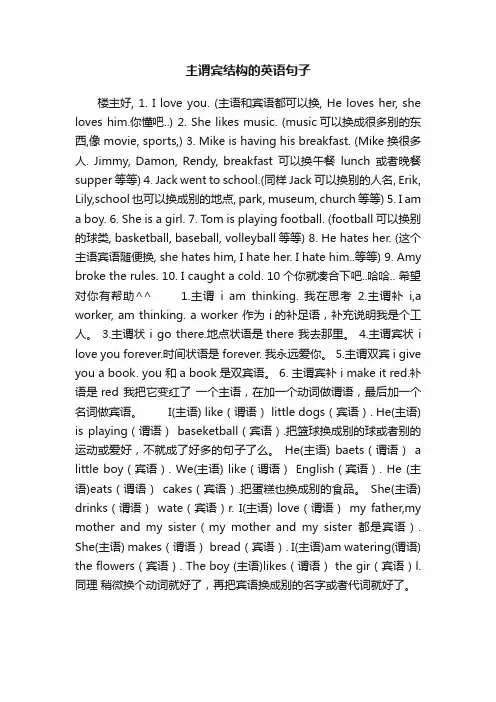
主谓宾结构的英语句子楼主好, 1. I love you. (主语和宾语都可以换, He loves her, she loves him.你懂吧..) 2. She likes music. (music可以换成很多别的东西,像 movie, sports,) 3. Mike is having his breakfast. (Mike换很多人. Jimmy, Damon, Rendy, breakfast可以换午餐lunch或者晚餐supper等等) 4. Jack went to school.(同样Jack可以换别的人名, Erik, Lily,school也可以换成别的地点, park, museum, church等等) 5. I am a boy. 6. She is a girl. 7. Tom is playing football. (football可以换别的球类, basketball, baseball, volleyball等等) 8. He hates her. (这个主语宾语随便换, she hates him, I hate her. I hate him..等等) 9. Amy broke the rules. 10. I caught a cold. 10个你就凑合下吧..哈哈.. 希望对你有帮助^^ 1.主谓i am thinking. 我在思考2.主谓补i,a worker, am thinking. a worker 作为 i的补足语,补充说明我是个工人。
3.主谓状 i go there.地点状语是there 我去那里。
4.主谓宾状 i love you forever.时间状语是forever. 我永远爱你。
5.主谓双宾 i give you a book. you 和a book是双宾语。
6. 主谓宾补 i make it red.补语是red 我把它变红了一个主语,在加一个动词做谓语,最后加一个名词做宾语。
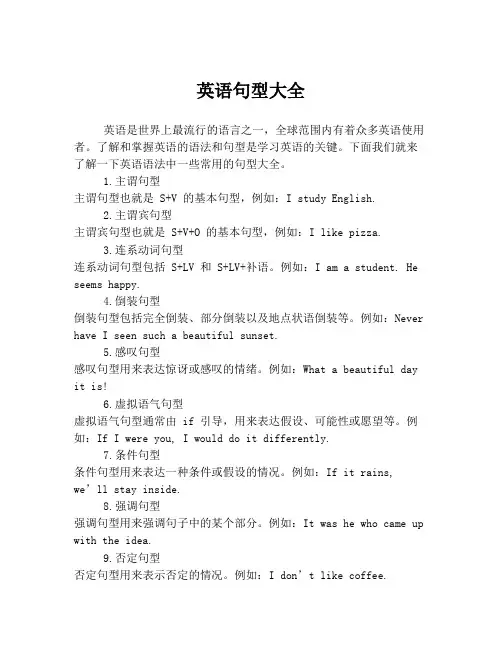
英语句型大全英语是世界上最流行的语言之一,全球范围内有着众多英语使用者。
了解和掌握英语的语法和句型是学习英语的关键。
下面我们就来了解一下英语语法中一些常用的句型大全。
1.主谓句型主谓句型也就是 S+V 的基本句型,例如:I study English.2.主谓宾句型主谓宾句型也就是 S+V+O 的基本句型,例如:I like pizza.3.连系动词句型连系动词句型包括 S+LV 和 S+LV+补语。
例如:I am a student. He seems happy.4.倒装句型倒装句型包括完全倒装、部分倒装以及地点状语倒装等。
例如:Never have I seen such a beautiful sunset.5.感叹句型感叹句型用来表达惊讶或感叹的情绪。
例如:What a beautiful day it is!6.虚拟语气句型虚拟语气句型通常由 if 引导,用来表达假设、可能性或愿望等。
例如:If I were you, I would do it differently.7.条件句型条件句型用来表达一种条件或假设的情况。
例如:If it rains, we’ll stay inside.8.强调句型强调句型用来强调句子中的某个部分。
例如:It was he who came up with the idea.9.否定句型否定句型用来表示否定的情况。
例如:I don’t like coffee.10.疑问句型疑问句型用来提出疑问或问题。
例如:Where is the nearest subway station?以上就是英语语法中常用的句型大全。
在学习英语的过程中,了解这些常用的句型,可以帮助我们更好地理解和运用英语。
同时也需要多多练习,熟悉各种句型的用法和语感。
祝愿大家在英语学习的过程中取得好的成绩!。
英语主谓宾宾例句英语中的主谓宾结构是指一个句子中的主语、谓语和宾语的关系。
它通常是最基本的句子结构,也是我们在学习英语语法时需要掌握的一项重要知识。
以下是一些常见的英语主谓宾宾例句:1. She gave me a book.她给了我一本书。
在这个句子中,主语是“she”,谓语是“gave”,第一个宾语是“me”,第二个宾语是“a book”。
2. He bought his girlfriend a necklace.他给他女朋友买了一条项链。
在这个句子中,主语是“he”,谓语是“bought”,第一个宾语是“his girlfriend”,第二个宾语是“a necklace”。
3. They showed us their vacation photos.他们给我们展示了他们的度假照片。
在这个句子中,主语是“they”,谓语是“showed”,第一个宾语是“us”,第二个宾语是“their vacation photos”。
4. The teacher gave the students a quiz.老师给学生们出了一份测验。
在这个句子中,主语是“the teacher”,谓语是“gave”,第一个宾语是“the students”,第二个宾语是“a quiz”。
5. I sent my sister a birthday card.我给我姐姐寄了一张生日卡。
在这个句子中,主语是“I”,谓语是“sent”,第一个宾语是“my sister”,第二个宾语是“a birthday card”。
以上是英语中常见的主谓宾宾结构的例句,我们在学习英语语法时要认真研究和理解这些句子的结构,以便更好地掌握英语语言的基本规则。
同时,在我们写作中也要尽量运用正确的句子结构,以保证我们的表达准确、清晰。
五种【2 】根本句型——主谓宾宾(宾补)构造主语+谓语+宾语(somebody)+宾语(something)主语+谓语+宾语+宾语补足语这个句型的语后面有两个宾语,这两个宾语放在一路叫双宾语(直接宾语+直接宾语)例如:Lend me your dictionary, please.这里“me”和“a book”一人一物做宾语就是双宾语这两个宾语:前一个宾语称为"间接宾语",多由代词或名词充当,平日为“人”;后一个宾语称为"直接宾语",往往由名词充当,平日为“物”.这类句型常有"给或人某物"."送或人某物"."留给或人某物"等意思.常见的这类谓语动词有:give(给或人……),bring(带给或人……), bring somebody somethingtell(告知或人……), tell somebody somethingsend(送给或人……), send somebody somethingleave(留给或人……), leave somebody somethingpass(递给或人……), pass somebody somethingread(给或人读……), read somebody somethingwrite(给或人写……), write somebody somethingtake(给或人拿……), take somebody somethingshow(给或人看……), show somebody somethingteach(教给或人……), teach somebody somethingget(给或人弄到……), get somebody somethinglend(借给或人……), lend somebody somethingbuy(给或人买……), buy somebody somethingpay(付出给或人……), pay somebody somethinghand(递给或人……) .hand somebody something注:上面各词的中文释义是锐意按照该词的常用动词句型而给的,以便于大家更好地懂得该词消失于哪个根本句型中.例如:She brought me a shirt .她给我带来一件衬衣.Pass him the dictionary, please.请将词典递给他.I lend him my bicycle.我把自行车借给他了.五种根本句型之主语+谓语+宾语+宾语补足语语法书上又叫做主语+谓语+复合宾语,这里的复合宾语=宾语+宾语补足语, 宾语补足语:例子:ask somebody to do something (邀请或人做某事)tell somebody to do something (告知或人做某事)want somebody to do something (请求或人做某事)1. I asked him to have dinner.谓语宾语宾语补足语2. He told me to clean the room.谓语宾语宾语补足语3. Tom wanted me to meet him .谓语宾语宾语补足语第一个句子,我邀请他吃饭,他(him)是作邀请(asked)的宾语,假如后面没有to have dinner ,句子意思就不完全,我邀请他,干什么呢?没说清晰,于是就有to have dinner来关心说清晰,是吃饭的,在这里的to have dinner 就是宾语补足语,这是动词不定式短语作宾补.to do 是动词不定式,但是假如动词不定式中的动词带有宾语或者动词不定式中的动词有副词来润饰,这时的动词不定式就成为不定式短语了.比如to do something 就是动词不定式短语,换句话说:这里 to have(动词不定式) to have dinner(动词不定式短语).又比如:to run是动词不定式to run fast 是动词不定式短语).上面的三个句子都是不定式短语作宾语不足语来关心宾语来补充解释.常见宾补的类型:doing \不带to的动词不定式\介词短语\形容词等等.请看下面的例句,留意不雅察划线的部分是有什么作的宾语补足语.:1.I saw a thief stealing something. 我看到一个贼正在偷器械2.He made me go home他让我回家3.Her mother kept her in the room . 她的妈妈让她待在房间里此句型的症结是记住那些动词后面是跟什么样的宾补.比如:我们可以说 ask somebody to do something (to do something 作宾补)我们就不能说 ask somebody doing something下面记住动词后面跟什么样的宾补口诀:1.动词后面是跟带to的动词不定式(动词不定式可以分为带to的动词不定式和不带to的不定式两种,不带to的不定式现实上就是动词本相)作宾补的order somebody to do somethingwant somebody to do somethingtell somebody to do somethinginvite somebody to do somethingask somebody to do somethingbeg somebody to do something(留意上面的有六个单词可以跟动词不定式作宾补,我们可以按照语气的强弱来记忆这几个单词:敕令>请求>告知>邀请>请求>乞求)此外,还有 advise somebody to do somethingallow somebody to do somethingwarn somebody to do somethingteach somebody to do something2. 动词后面可以跟不带to的动词不定式作宾补的口决:一感二听三让五看半关心这里:一感(feel)二听(hear\listen to )三让(let \make\have)五看(see\watch\notice\observe\look at)半关心(help).即: feel hear listen to let make leave somebody do sth see watch notice observe look at help4. 动词后面是跟doing作宾补的,可以借助上面的句子来记忆,上面的单词中除了三让(have\let\make)半关心(help)不能跟dong作宾补之外,其它都是可以的.(即:一感二听五看,现实上它们都属于感官动词)演习四一断定下列句子是主谓+双宾语构造照样主谓+复合宾语,假如是主谓+复合宾语,请指出复合宾语是由什么充当的.1. I watch the boy playing foot ball.2. My good friend told me a story3. Tom lent me a pencil.4. LiLi noticed two dogs fight .5. I looked at her flying a kite .6. Please hand me the paper .7. The lion ordered the hen to give him some eggs.8. He wanted you to go with him.9. Lu Yang told the little boy to go home.10. She asks me to help her . 11. My parents leave me some money .12. Lucy leads me a pencil . 13. Mother got me some tea .14. LiLei found 100 yuan in the room. 15. He showed me her photos .16. The fans made Lin Junjie a famous star.17. Mom let me in. 18. The rich man bought his son an MP4.19. The teacher observes the boy sleep. 20. The teacher made her monitor.21. I saw the baby cry. 22. I paid him three yuan .23. He passed me an eraser. 24. Lucy heard her neighbor singing25. Tom teaches us English. 26. They asked the teacher to explain it again .27. Let me read you his letter . 28. Would you sing us an English song ?29. I will lend you something. 30. Did you notice me leave the house演习四答案1. I watch the boy playing foot ball.我看到谁人男孩在踢足球.主谓+宾语+宾补.playing foot ball做宾补2. My good friend told me a story我的好同伙给我讲了一个故事.主谓+双宾3. Tom lent me a pencil.汤姆借给我一个铅笔.主谓+双宾4. LiLi noticed two dogs fight.李利留意到两个狗在打架.主谓+宾语+宾补,fight做宾补5. I looked at her flying a kite.我看到她在放风筝.主谓+宾语+宾补.flying a kite做宾补6. Please hand me the paper .请递给我一张纸.主谓+双宾7. The lion ordered the hen to give him some eggs.那头狮子敕令那只母鸡给他一些鸡蛋.主谓+宾语+宾补.to give him some eggs做宾补8. He wanted you to go with him.他要你一路跟他去.主谓+宾语+宾补.to go with him做宾补9. Li Yang told the little boy to go home.李扬叫谁人小男孩回家.主谓+宾语+宾补.to go home做宾补10. She asks me to help her .她请我去关心她.主谓+宾语+宾补.to help her做宾补11. My parents leave me some money .我的怙恃亲留给我一些钱.主谓+双宾12. Tom leads me a pencil .汤姆借给我一只铅笔.主谓+双宾13. Mother got me some tea .妈妈给我取了一些茶.主谓+双宾14. LiLei found 100 yuan in the room.李蕾发明有100元在房间里/李蕾在房间里发明了100元.主谓+宾语+宾补.in the room做宾补15. He showed me her photos .他让我看了看她的照片.主谓+双宾16. The fans made Lin Junjie a famous star.那些粉丝们让林俊杰成为一个明星.主谓+双宾17. Mom let me in.妈妈让我进去.主谓+宾语+宾补.in做宾补18. The rich man bought his son an MP4.谁人有钱人给他的儿子买了一个MP4.主谓+双宾19. The teacher observes the boy sleep.谁人先生不雅察到谁人男孩睡觉了.主谓+宾语+宾补.sleep做宾补20. The teacher made her monitor.先生让她做班长.主谓+双宾21. I saw the baby cry.我看到谁人男孩哭了.主谓+宾语+宾补.cry做宾补22. I paid him three yuan .我付给他三元.主谓+双宾23. He passed me an eraser.他递给我一个橡皮.主谓+双宾24. She heard her neighbor singing她听到她的邻人在唱歌.主谓+宾语+宾补.singing做宾补25. Tom teaches us English.汤姆教我们英语.主谓+双宾26. They asked the teacher to explain it again .他们请先生在解释一遍.主谓+宾语+宾补.to explain it again做宾补27. Let me read you his letter .让我给你读读他的信.主谓+双宾28. Would you sing us an English song ?你可以给我们唱支英文歌吗?主谓+双宾29. I will lend you a book .我将借给你`一本书.主谓+双宾30. Did you notice me leave the house?你留意到我分开房子吗?主谓+双宾。
关于英语五个简单句的讲解
当我们讲解英语中的五个简单句时,我们可以从基本句型、结构和语法角度入手,通过简单的例句来说明。
以下是五个简单句的讲解:一、主+ 谓:
例句:She sings.
解释:这是最简单的英语句子结构,由主语和动词构成。
主语She 进行动作sings。
二、主+ 谓+ 宾:
例句:He reads a book.
解释:除了主语和动词外,这个句子还有一个宾语 a book,表示动作的对象。
三、主+ 谓+ 宾+ 宾补:
例句:She painted the wall red.
解释:在这个句子中,red是宾补,表示宾语the wall的状态或性质。
四、主+ 谓+ 宾+ 间宾+ 直宾:
例句:He gave her a present.
解释:这个句子有两个宾语,her是间接宾语,表示动作的接受者;a present是直接宾语,表示动作的对象。
五、主+ 系+ 表:
例句:The flowers are beautiful.
解释:这个句子中,are是系动词,连接主语The flowers和表语
beautiful,表示主语的状态。
主谓宾定状补例句主谓宾定状补是英语句子中常见的一种句型结构。
它由主语、谓语、宾语、定语、状语和补语组成,其中定语用来修饰宾语,状语用来修饰谓语动词,补语用来补充说明主语或宾语的状态或属性。
下面是一些关于主谓宾定状补的例句。
1. My mother made me a cup of hot tea.(我的妈妈给我做了一杯热茶。
)主语:My mother谓语:made宾语:a cup of hot tea定语:hot状语:没有补语:me2. The teacher found the students disorganized.(老师发现学生们杂乱无章。
)主语:The teacher谓语:found宾语:the students定语:disorganized状语:没有补语:没有3. He painted his house blue.(他把他的房子涂成了蓝色。
)主语:He谓语:painted宾语:his house定语:blue状语:没有补语:没有4. The storm left the city in ruins. (暴风雨使这个城市变得一片废墟。
)主语:The storm谓语:left宾语:the city定语:in ruins状语:没有补语:没有5. We found the movie incredibly boring. (我们觉得这部电影无聊至极。
)主语:We谓语:found宾语:the movie定语:incredibly boring状语:没有补语:没有6. She considered the job too challenging. (她认为这份工作太具有挑战性。
)主语:She谓语:considered宾语:the job定语:too challenging状语:没有补语:没有7. The doctor declared the patient healthy. (医生宣布病人身体健康。
英语语法主谓宾讲解
1、主谓结构:I run 谓语一般是不及物动词,后面不加宾语。
2、主谓宾结构:I play basketball这里的谓语是及物动词后面加宾语。
3、主谓加双宾:I give you a book这里的you.book都是宾语。
4、主谓宾加宾补:I found the book interesting 这里的interesting是宾补。
扩展资料
主谓宾=主语+实义动词+宾语,be是系动词,不能用于主谓宾中。
主系表=主语+系动词(最常见的是be,还有“五感”feel、look、sound、smell、taste 和其它动词如become、grow…等)+表语(名词、代词、形容词、时间地点副词、介词短语、表语从句…等)。
I am a boy.这句话中没有宾语,属于主系表,I是主语,系动词am是谓语动词,a boy是表语,系动词和表语合起来作谓语。
由此可见在主系表中,谓语≠谓语动词;而在主谓宾中,谓语=谓语动词,如I love you。
总之,系动词和宾语是不共戴天的仇人,誓不两立。
系动词后面接的是表语,而宾语前面接的是谓语。
英语主谓宾例句1. The dog chased the cat. (狗追猫。
)这个句子是一个典型的主谓宾结构。
主语是"The dog",谓语是"chased",宾语是"the cat"。
其中,主语指的是执行动作的人或物,谓语则是施加给主语的动作或状态,宾语则是动作的承受者。
2. She cooked dinner last night. (昨晚她做了晚餐。
)这个句子中的主谓宾结构是"She cooked dinner"。
主语是"She",谓语是"cooked",宾语是"dinner"。
这句话表达了一个女人过去做晚饭的行为,是一个典型的过去式句子。
3. The student read a book. (学生读了一本书。
)这个句子中的主谓宾结构是"The student read"。
主语是"The student",谓语是"read",宾语是"a book"。
这个句子是一个简单的陈述句。
4. My mother loves cooking. (我母亲喜欢做饭。
)这个句子中的主谓宾结构是"My mother loves cooking"。
主语是"My mother",谓语是"loves",宾语是"cooking"。
这个句子表达了母亲对做饭的喜爱之情。
5. He drives a car to work. (他驾车上班。
)这个句子中的主谓宾结构是"He drives a car"。
主语是"He",谓语是"drives",宾语是"a car"。
英语句子成分结构详解定语| 状语| 宾语| 补语| 同位语| 独立成分| 分词独立结构一、英语语句基本结构分析:>> 主谓宾结构:主语:可以作主语的成分有名词(如boy),主格代词(如you),动词不定式,动名词等。
主语一般在句首。
注意名词单数形式常和冠词不分家!谓语:谓语由动词构成,是英语时态、语态变化的主角,一般在主语之后。
不及物动词(vi.)没有宾语,形成主谓结构,如:We come.宾语:宾语位于及物动词之后,一般同主语构成一样,不同的是构成宾语的代词必须是‘代词宾格’,如:me,him,them等例:The boy needs a pen.主语the boy,谓语needs(need的第三人称单数形式),宾语a pen. >> 主系表结构:主语:同‘主谓宾’结构。
联系动词(Link verb):be动词(am,is,are,was,were,have been);其他联系动词如:become 成为,turn变成,go变。
其特点是联系动词与其后的表语没有动宾关系,表语多为形容词或副词,既,不可能是宾语。
感官动词多可用作联系动词:look well/面色好,sound nice/听起来不错,feel good/感觉好,smell bad/难闻。
表语:说明主语的状态、性质、等。
可为形容词、副词、名词、代词、不定式、分词。
当联系动词不是be,而其后是名词和代词时,多表达‘转变为’之意,注意与动宾关系的区别。
例:Tom is a boy.(Tom是个男孩)/主语为Tom,系词为be动词的第三人称单数is,表语为a boy>> There be 结构:There be 表示‘存在有’。
这里的there没有实际意义,不可与副词‘there那里’混淆。
此结构后跟名词,表示‘(存在)有某事物’试比较:There is a boy there.(那儿有一个男孩。
)/前一个there无实意,后一个there 为副词‘那里’。
二、定语:定语是对名词或代词起修饰、限定作用的词、短语或句子,汉语中常用‘……的’表示。
定语通常位于被修饰的成分前。
若修饰some,any,every,no构成的复合不定代词时,(如:something、nothing);或不定式、分词短语作定语、从句作定语时,则定语通常置后。
副词用作定语时须放在名词之后。
形容词作定语:{定语置前}The little boy needs a blue pen.(little修饰名词boy;blue修饰名词pen.)/小男孩需要一支兰色的钢笔。
Tom is a handsome boy./Tom是个英俊的男孩。
There is a good boy./有个乖男孩。
数词作定语相当于形容词:Two boys need two pens./两个男孩需要两支钢笔。
The two boys are students./这两个男孩是学生。
There are two boys in the room./房间里有两个男孩。
代词或名词所有格作定语:{定语置前}His boy needs Tom\'s pen./他的男孩需要Tom的钢笔。
His name is Tom./他的名字是汤姆。
There are two boys of Toms there./那儿有Tom家的两个男孩。
名词作定语:{定语置前}The boy needs a ball pen./男孩需要一支圆珠笔。
It is a ball pen./这是一支圆珠笔。
There is only one ball pen in the pencil box./这铅笔盒里只有一支圆珠笔。
介词短语作定语:{定语置后}The boy in the classroom needs a pen of yours./教室里的男孩需要你的一支钢笔。
The boy in blue is Tom./穿兰色衣服的孩子是汤姆。
There are two boys of 9,and three of 10./有两个9岁的,三个10岁的男孩。
副词作定语:{定语置后}The boy there needs a pen./那儿的男孩需要一支钢笔。
The best boy here is Tom./这里最棒的男孩是Tom。
不定式作定语:{定语置后}The boy to write this letter needs a pen./写这封信的男孩需要一支钢笔。
There is nothing to do today./今天无事要做。
分词(短语)作定语:{定语置后}The smiling boy needs a pen bought by his mother./那个微笑的男孩需要一支他妈妈买的钢笔。
The pen bought by her is made in China./她买的笔是中国产的。
There are five boys left./有五个留下的男孩。
定语从句:{定语置后}The boy who is reading needs the pen which you bought yesterday./那个在阅读的男孩需要你昨天买的钢笔。
The boy you will know is Tom./你将认识的男孩叫汤姆。
There are five boys who will play the game./参加游戏的男孩有五个。
三、状语:状语修饰动词、形容词、副词或全句,说明方式、因果、条件、时间、地点、让步、方向、程度、目的等。
状语在句子中的位置很灵活,常见情况为:通常在句子基本结构之后,强调时放在句首;修饰形容词或副词时,通常位于被修饰的词之前;表示时间、地点、目的的状语一般位于句子两头,强调时放在句首,地点状语一般须在时间状语之前;一些表示不确定时间(如:often)或程度(如:almost)的副词状语通常位于be动词、助动词、情态动词之后,动词之前。
有时状语在句中的某个位置会引起歧义,应注意,如:The boy calls the girl in the classroom.一般理解成‘男孩喊教室里的女孩‘(此时in the classroom为girl的定语),也可以理解为‘男孩在教室里喊女孩’(此时in the classroom为地点状语),最好写作‘In the classroom,the boy calls the girl.\'副词(短语)作状语:{状语置后}The boy needs a pen very much./男孩非常需要一支钢笔。
(程度状语)The boy needs very much the pen bought by his mother./男孩非常需要他母亲买的那支钢笔。
(宾语较长则状语前置)The boy really needs a pen./男孩真的需要一支钢笔。
(不确定程度状语置于动词之前)The boy needs a pen now./Now,the boy needs a pen./The boy,now,needs a pen./男孩现在需要一支钢笔。
(时间状语)介词短语作状语:{强调状语置前}In the classroom,the boy needs a pen./在教室里,男孩需要一支钢笔。
(地点状语)Before his mother,Tom is always a boy./在母亲面前,汤姆总是一个男孩子.(条件状语) On Sundays,there is no student in the classroom./星期天,教室里没有学生.(时间状语) 分词(短语)作状语:{状语置后}He sits there,asking for a pen./他坐在那儿要一支笔。
(表示伴随状态)Having to finish his homework,the boy needs a pen./因为不得不完成作业,男孩需要一支笔。
(原因状语,强调置前)Frightened,he sits there soundlessly./(因为)受了惊吓,他无声地坐在那儿。
(原因状语)不定式作状语:The boy needs a pen to do his homework./男孩需要一支笔写家庭作业。
(目的状语置前)To make his dream come true,Tom becomes very interested in business./为实现梦想,汤姆变得对商业很有兴趣. (目的状语强调时置前)名词作状语:{状语置后}Come this way!/走这条路!(方向状语)四、直接宾语和间接宾语:>>>特殊的同源宾语现象: fight a fight , dream a dream , etc.有些及物动词可以有两个宾语,如:give给,pass递,bring带,show显示。
这两个宾语通常一个指人,为间接宾语;一个指物,为直接宾语。
间接宾语一般位于直接宾语之前。
一般的顺序为:动词 + 间接宾语 + 直接宾语。
如:Give me a cup of tea,please.强调间接宾语顺序为:动词 + 直接宾语 + to + 间接宾语。
如:Show this house to .若直接宾语为人称代词:动词+ 代词直接宾语 + to + 间接宾语。
如:Bring it to me,please.五、宾语补足语:位于宾语之后对宾语作出说明的成分。
宾语与其补足语有逻辑上的主谓关系,它们一起构成复合宾语。
名词/代词宾格 + 名词The war made him a soldier./战争使他成为一名战士.名词/代词宾格 + 形容词New methods make the job easy./新方法使这项工作变得轻松.名词/代词宾格 + 介词短语I often find him at work./我经常发现他在工作.名词/代词宾格 + 动词不定式The teacher ask the students to close the windows./老师让学生们关上窗户.名词/代词宾格 + 分词I saw a cat running across the road./我看见一只猫跑过了马路.六、同位语:同位语是在名词或代词之后并列名词或代词对前者加以说明的成分,近乎于后置定语。
如:We students should study hard. / (students是we的同位语,都是指同一批‘学生’)We all are students. / (all是we的同位语,都指同样的‘我们’)七、独立成分:有时句子中会有一些与句子没有语法联系的成分,称为句子独立成分(注意:区别于分词独立结构)。